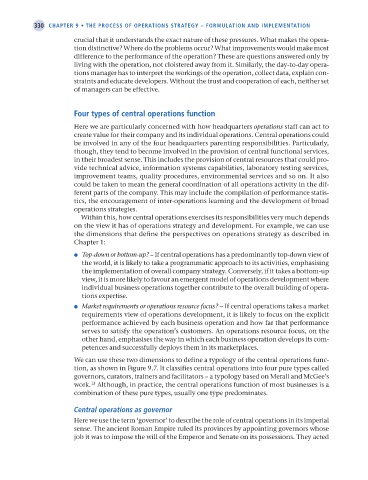Page 355 - Operations Strategy
P. 355
330 CHAPTER 9 • THE PRoCEss of oPERATions sTRATEgy – foRmulATion And imPlEmEnTATion
crucial that it understands the exact nature of these pressures. What makes the opera-
tion distinctive? Where do the problems occur? What improvements would make most
difference to the performance of the operation? These are questions answered only by
living with the operation, not cloistered away from it. Similarly, the day-to-day opera-
tions manager has to interpret the workings of the operation, collect data, explain con-
straints and educate developers. Without the trust and cooperation of each, neither set
of managers can be effective.
Four types of central operations function
Here we are particularly concerned with how headquarters operations staff can act to
create value for their company and its individual operations. Central operations could
be involved in any of the four headquarters parenting responsibilities. Particularly,
though, they tend to become involved in the provision of central functional services,
in their broadest sense. This includes the provision of central resources that could pro-
vide technical advice, information systems capabilities, laboratory testing services,
improvement teams, quality procedures, environmental services and so on. It also
could be taken to mean the general coordination of all operations activity in the dif-
ferent parts of the company. This may include the compilation of performance statis-
tics, the encouragement of inter-operations learning and the development of broad
operations strategies.
Within this, how central operations exercises its responsibilities very much depends
on the view it has of operations strategy and development. For example, we can use
the dimensions that define the perspectives on operations strategy as described in
Chapter 1:
● Top-down or bottom-up? – If central operations has a predominantly top-down view of
the world, it is likely to take a programmatic approach to its activities, emphasising
the implementation of overall company strategy. Conversely, if it takes a bottom-up
view, it is more likely to favour an emergent model of operations development where
individual business operations together contribute to the overall building of opera-
tions expertise.
● Market requirements or operations resource focus? – If central operations takes a market
requirements view of operations development, it is likely to focus on the explicit
performance achieved by each business operation and how far that performance
serves to satisfy the operation’s customers. An operations resource focus, on the
other hand, emphasises the way in which each business operation develops its com-
petences and successfully deploys them in its marketplaces.
We can use these two dimensions to define a typology of the central operations func-
tion, as shown in Figure 9.7. It classifies central operations into four pure types called
governors, curators, trainers and facilitators – a typology based on Merali and McGee’s
work. Although, in practice, the central operations function of most businesses is a
13
combination of these pure types, usually one type predominates.
Central operations as governor
Here we use the term ‘governor’ to describe the role of central operations in its imperial
sense. The ancient Roman Empire ruled its provinces by appointing governors whose
job it was to impose the will of the Emperor and Senate on its possessions. They acted
M09 Operations Strategy 62492.indd 330 02/03/2017 13:27

